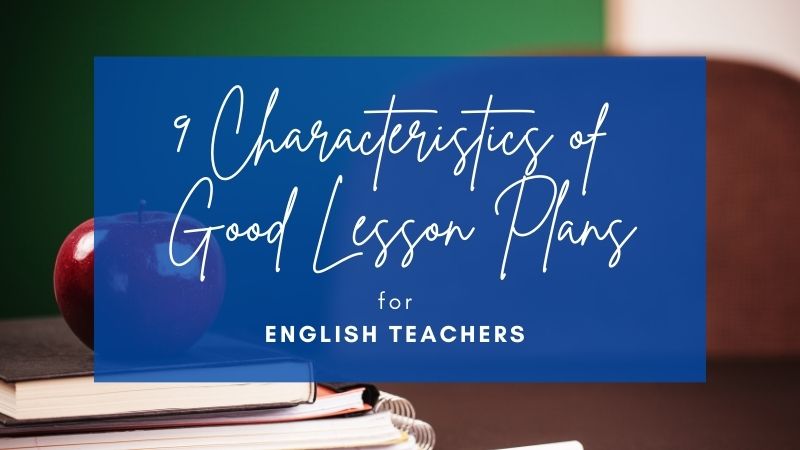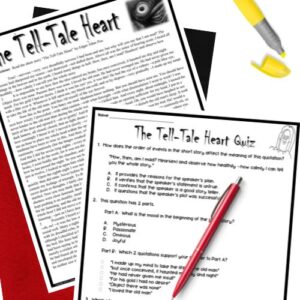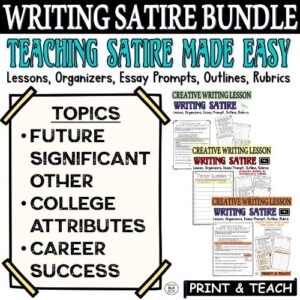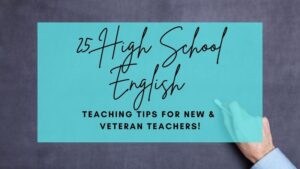What makes good English Lesson Plans for Teachers? This is a question that could be debated for years and years, as educational research is always changing. I know when I started teaching 18 years ago, the goal in my college of education was to create plans…loads and loads of plans. We had no real experience producing lesson plans with actual teachers who were currently in the classroom.
Instead, we were regulated and guided by professors who had NOT taught in a decade or more. Clearly, this education was not helpful in developing English Lesson Plans for Teachers!
And all I can remember from my teacher education program is the following techniques:
- Don’t teach grammar. Let kids write and let the writing flow. Direct instruction in grammar need not be attempted.
- Read FUN things with students. Whatever this means, I still do not know.
- Use proximity control. Apparently, just being near students will cause them to suddenly become disciplined scholars.
Yup, this list is about it. Most of what I learned in college was useless. Trust me. My first year of teaching ninth-grade English was a horror show!
Through the years, I have figured out a few things, and the list below encapsulates the most important elements of English Lesson Plans for Teachers!
Need help with Test Prep to include in your English Lesson Plans for Teachers? Check out this FREE Pack of 3 Test Prep Activities to help students achieve success on standardized tests!
9 Characteristics of Good English Lesson Plans for Teachers
1. Includes Objectives/Goals Linked to the Standards
Ultimately, all lesson plans should have standards-based objectives/goals for the day, week, unit, etc. If you simply want students to create a movie poster based on a short story or read a passage and talk about it, your students will never actually prove they have the knowledge or skills learned from the lesson.
Let’s say you are reading “The Tell-Tale Heart” by Edgar Allan Poe. Your ultimate objective is NOT merely to read the story. You shouldn’t even necessarily choose a text because you like it.
Instead, you should choose your objectives first, choose an activity to demonstrate the objective, and then choose a text that best helps your students with mastering the standards.
EXAMPLE OBJECTIVES IN ENGLISH LESSON PLANS FOR TEACHERS:
- Students will identify the traits of various characters within a text.
- Students will use evidence to support the identified character traits.
- Students will analyze how characters’ traits change or stay the same throughout a text.
- Students will examine how a change in various characters’ traits, or lack thereof, contributes to the theme of the text.
2. Includes a Timeline
I am not talking about minute-by-minute necessarily; however, when I first started creating English Lesson Plans for Teachers, I REALLY needed a structure this specific.
EXAMPLE DAILY TIMELINE in English Lesson Plans for Teachers: (90min)
- Bell-Ringer-10min (linked to the topic and/or standard)
- Whole Group Lesson-15-25min (reading + introduction of skill/standard)
- Small Group/Independent Work-30-45min (independent reading + skills/standards practice)
- Closing Activity-5min (a quick check on skill/standard)
Your timeline might be a bit more general. You could plan daily, weekly, monthly, or even by text or unit.
I personally love the flexibility of teaching by unit with a day-to-day action plan.
3. Includes Scaffolded Activities
Most of our students don’t come to us at grade level. In fact, too many students struggle with reading and writing. Because of their abilities, we need to scaffold lessons for students.
You can scaffold within 1 day, or you can scaffold throughout a unit.
- Bell-Ringer: Ask your students what character traits define you as an individual. To scaffold even further, you may want to provide several examples.
- Whole Group Lesson: I DO-Introduce indirect/direct characterization and read a small excerpt of a passage. Model to your students what identifying a trait looks like. WE DO-Read another excerpt or chunk of the passage. Let students help you identify evidence that links to specific traits.
- Small Group/Independent Work: YOU DO-Let students finish reading in small groups or quietly to themselves. Have students identify character traits near the end of the story.
- Closing Activity: In a QuickWrite, let students answer the question: How did a character change throughout the story? What evidence proves the character changed?
Here is a done-for-you Literary Analysis Character Trait Activity for “The Tell-Tale Heart!”
4. Includes Engaging Content
If you have a choice in what you teach, then incorporating engaging content is quite easy. Simply, determine the standards you want to teach and use texts and activities that your students will connect with in some way.
Now, I am not advocating avoiding difficult, complex, or repetitive content. In fact, students, especially our students who struggle, need exposure to more rigorous content. It is all in how you teach it!
WAYS TO MAKE CONTENT MORE ENGAGING IN YOUR ENGLISH LESSON PLANS FOR TEACHERS:
- Introduce the text or activity with a video or movie clip.
- Have students write about a connected topic at the start of the lesson.
- Break up a reading passage into chunks.
- Encourage students to visualize as they read.
- Let students act out what is happening before the assessment.
- Allow students to read in pairs or small groups.
- Take a break in between activities.
- Include a review game.
- Get students up and moving around to different spots in the classroom.
- Combine an older passage with a contemporary passage.
5. Includes Relevant Ideas
If you are teaching a text from classic literature simply because you grew up loving it, this might not be the most effective choice. Major ideas within the lesson need to be relevant for today.
For example, if you are teaching satire, you may want to have your students read “Sending Grandma to the Ovens” instead of “A Modest Proposal.” There is a discussion right now about how we treat our elderly and how those who have died might be used in compost….these ideas directly connect to “Sending Grandma to the Ovens.”
If you are teaching theme, you don’t have to use an entire novel to do so. Why not include a similar short story or poem in your English Lesson Plans for Teachers?
If you are teaching students how to write a resume, make sure to do your research. Many companies are not requiring a cover letter. That information for your students would be outdated.
6. Includes Differentiated Instruction
Because we have so many students with IEPs or 504 plans, we need to be aware of differentiated instruction techniques. No longer can we just teach our students as a whole group and expect to fulfill our responsibility as an educator.
7 Strategies for Differentiation you can incorporate in your English Lesson Plans for Teachers:
#1 By Reading Passages
When including a specific text such as Edgar Allan Poe’s “The Tell-Tale Heart” you could use the original version. But another option is to use one designed for struggling readers. There are websites such Rewordify.com that can recreate passages based on Lexile levels. You could also shift to another text or provide different options. Think about using “The Tell-Tale Heart” versus “The Masque of the Red Death.”
#2 By Reading Assignments
Another way you can use strategies of differentiation is through reading activities. Individual assignments can be modified based on student needs. Here, it is optimal to establish the success criteria for the lesson and figure out how students might best meet those criteria in the time allotted for the task. For some, it will mean more steps, and for others less because of the time constraint.
#3 By Writing Activities
This example of a product for differentiation explains that some students might write a full essay, and others might write a paragraph or a 2-3 sentence response instead. In this or another assignment, if 4 pieces of evidence are required, then some students might instead include 2 pieces of evidence. If 5 sources are required, then it might shift to 2 or 3 instead to support the content.
#4 By Rubric
A rubric is a ‘living’ document in that it can change to meet the needs of the assignment and the class. In the example above with shifting an assignment’s form, you want to make sure that your rubric clearly identifies the success criteria for the task and that each form – essay, outline, poem – fits the criteria and provides students a chance to be successful in meeting the criteria.
#5 By Extension Activities
When a student is done with her or his work, we can provide differentiated games, puzzles, and creative writing prompts. This strategy doesn’t mean adding busy work but rather extending their thinking and learning beyond the lesson.
#6 By Unit Final Project (Strategies of Differentiation)
Differentiation still focuses on a rigorous outcome but gives students the option to extend ideas beyond an essay. Here are some examples!
- Advertisement for a novel, play, poem, short story, etc.
- Trailer for a piece of literature. (They can create by hand or using a program like Canva for Education.)
- Create a “website” based on a text. (There are lots of free student-friendly options students can use. If you’re a Google-based school then Google Sites is an easy option.)
#7 By Discussion/Topic
Socratic seminars can be used in various ways. To support learners, you can also provide question and sentence stems, whole questions, and topics, or leave it to student choice!
7. Includes References to Past/Future English Lesson Plans for Teachers
English Lesson Plans for Teachers should not be taught in isolation. Think of your lessons as a continuing conversation with a friend. You talk about your past, discuss the present, and dream about the future together.
As much as possible, have your English Lesson Plans for Teachers throughout the year connect in some way.
You can accomplish this element in several ways:
- By Standards-Remember, we learn through repetition. If you think you taught an awesome lesson on central idea once or twice, and that is enough….well, it isn’t.
- By Concepts-This aspect might include similar units or passages like a unit on Dystopian Ideas!
- By Skills-Teaching a writing unit is fantastic, but you need to be sure to build on what students already know and how they can grow in the future.
Click below to read about 25 tips for High School English Teachers!
8. Includes Diverse Strategies
Because we have diverse learners, we need diverse strategies within our English Lesson Plans for Teachers. Gone are the days of a teacher standing at the front of the classroom as the students sit quietly at their desks basking in a whole group lecture.
So we have to consider not just the strategies needed for subject areas but also the various ways we can manage our students.
Here are my top 10 strategies I consider when creating English Lesson Plans for Teachers:
- After an activity, assess your students in some way. My favorite way is to assign a small task, give students time to complete the assignment, and then they come up to me for a grade, feedback, and/or revision ideas.
- Set aside time for small group or individual conferences. Let’s say you are having your students write an essay, poem, or short story. Call your students to a particular part of the room or walk around to students and chat with them for a couple of minutes. Some students may not want help, but I find that most students want affirmation or direction.
- Break up the day. Many teachers may have only 50 minutes to teach, but some have the task of filling 90 minutes. Now, that can be overwhelming. Feel free to break up the day into several activities. We all need some variance in our days.
- Tell students exactly what to do. It will never cease to amaze me that students will walk into a classroom with a bell ringer clearly on the board. Well, you may need to tell your kids to take out a pen or pencil and a sheet of paper. We cannot assume our students will do what we want them to do without directly telling them.
- Try to fit in a Socratic Seminar. When students go to college, they will need the ability and confidence to ask questions and talk about what they know. If you teach how to do a Socratic Seminar, then your students can be talking in a productive way all year long.
- Type everything out. At my last school, I would use the board to type out what I was teaching, directions, things to consider, etc. If you merely tell students without writing it down, don’t expect them to remember.
- Think about rearranging students. Our students should not control our classrooms; however, ALL of their needs are key. Some kids may WANT to sit in the front with their friends, but that situation can quickly get out of control. Because many students have an IEP with required preferential seating, we do have to accommodate their needs. Most parents, thankfully, will work with teachers if their personal seating desires are obstructing their success.
- Create a list of IEP/504 strategies/accommodations within each lesson. If you have the list in every lesson and a link to each activity, you can easily justify how you supported and taught your students. This process saved me loads of time and headaches at the end of the grading period.
- Develop everything with the end in mind. It can be tough for a first-time teacher or a teacher in a new grade level to think this way. But if you can plan out each quarter with at least the standards, skills, major assessments, daily activities, and texts, you will save so much time and stress.
- Put all activities in the grade book ahead of time. I know putting everything in the grade book for each quarter may not be possible, BUT if you include the assignment, date due, and maybe a link for help, your students will have no ability to complain. And if you have to take something out, no one will really care 🙂
9. Includes Integrated Elements within English Lesson Plans for Teachers
We cannot teach reading in isolation. It is rare that a student is successful as a reader by simply reading a passage. We need to integrate multiple skills for students to grow when developing English Lesson Plans for Teachers!
Integrating listening, writing, researching, presenting, speaking, and grammar into a day, week, or month is vital. According to research, listening to a lecture is one of the MOST INEFFECTIVE ways for students to learn and retain knowledge.
Instead, our students need to maybe start with listening to what is read and then read a little on their own. After that, students can speak with a partner about the passage and write a response. In the writing response, you can ask students to include a semicolon (with a teacher example provided). At the end of the class, students can share out their written responses.
Notice: This one-day lesson covers 5 elements. As teachers, we pretty much participate in an integrated classroom as a part of our employment. Our students need to learn these skills, too!
Need more ideas for English Lesson Plans for Teachers? Check out my store Kristin Menke-Integrated ELA Test Prep!





